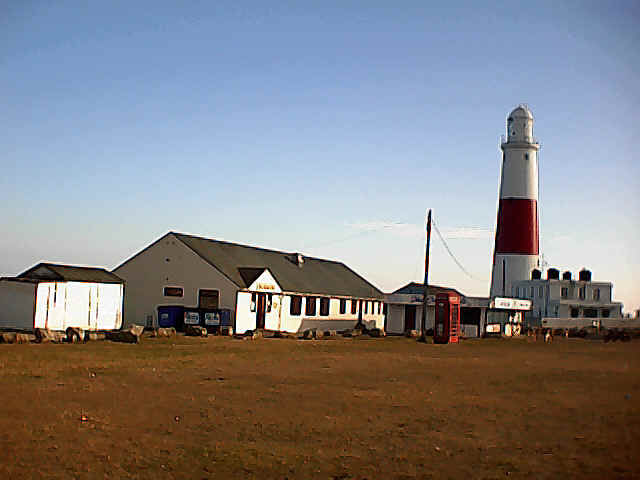|
 |
Portland
Bill and Chesil Beach are the graveyards of many vessels that failed to
reach Weymouth or Portland Roads. The Portland Race is caused by the
meeting of the tides between the Bill and the Shambles sandbank about 3
miles SE. Strong currents break the sea so fiercely that from the shore a
continuous disturbance can be seen. Portland Bill Lighthouse guides
vessels heading for Portland and Weymouth through these hazardous waters
as well as acting as a
way
mark
for ships navigating the English Channel. The Shambles sandbank is
marked
by a red sector light. |
|
New
high and low lighthouses were built in 1869. but early this century
Trinity House announced its intention of replacing them with a single
tower
-the
present lighthouse. The
old towers can still be seen from the outside - the low light has retained
its original appearance but the high light lantern has been
removed.
The
present optic at Portland Bill is
very
unusual as due to the arrangement of
the panels the character gradually changes from one flash to four flashes
between the bearings 221 °and 224° and from four flashes to one flash
between bearings 117° and 141°.
Portland
Bill Lighthouse was de-manned on 18th March 1996 when monitoring
and
control of the station was transferred to the Trinity House Operations
Control
Center at Harwich.
|
As
early as 1669 Sir John Clayton was granted a patent to erect a lighthouse.
but his scheme fell through and it was not until early in the eighteenth
century that Captain William Holman. supported by the ship owners and
Corporation of Weymouth. put a petition to Trinity House for the building
of a lighthouse at Portland Bill. Trinity House opposed it suggesting that
lights at this point were needless and ship owners could not bear the
burden of their upkeep. The people of Weymouth continued their petition
and on 26th May, 1716 Trinity House
obtained
a patent from George I. They in turn issued a lease for 61 years to a
private
consortium who built two lighthouses with enclosed lanterns and coal
fires.
The lights were badly kept, sometimes not
lit
at
all. and in 1752 an inspection was made by two
members
of the Board of Trinity House who
approached
by sea to find "it was nigh two hours
after
sunset before any light appeared in either of
the
lighthouses". With the termination of the lease the lights reverted to
Trinity House. In 1789
William
Johns, a builder of Weymouth under
contract
to Trinity House, took down one of the
towers
and erected a new one at a cost of £2,000. It was sited so that it served
as a mark by day or night
to
direct ships moving up and down Channel or into
Portland
Roads clear of the Race and Shambles. |
|
 |
Established in
1716
Position
:-
50°
30'.82 N 02° 27'.30 W
Height of tower:41M
Height
of light above mean high water:-
43
meters
Automated
Optic:-
4
panel 1st order catadioptric
fixed
lens.
Lamp Character:- White Group Flashing 4
times every 20 seconds.
Intensity:-
635,000
candela
Range
of light:- 25 Sea Miles
Fog
signal character:- One 3.5 Second Blast Every 30
seconds
|
|
In
1798. when Napoleon threatened invasion, two 181b cannons were installed
at
the lighthouse.
A
7 meter tall white stone obelisk was built in 1844 at the southern tip of
Portland
Bill as a warning of a low shelf of rock extending 30 meters into the sea.
which still stands near the current lighthouse.
|
In
August 1788 Argand lamps were installed.
Portland
being the first lighthouse in England to be fitted with them. In the
upper
or old house there were two rows, seven in each row, lighted with oil and
furnished
with highly-polished reflectors. Low light tests were made by Thomas
Rogers
with his new lens light, and six Argand lamps were installed, their lights
increased by lenses. |
|
The
lighthouse is open to the public from 1 April to 30 September, every day
except Saturday from 1
lam
to 5pm. The tower is not suitable
for all to climb as there are
153 steps also for safety reasons it is not possible to admit children of
less than 1.1 meters in height. However in addition to the tower there is
a visitors center at the site
containing a display about the lighthouse and the Isle of Portland. |
|